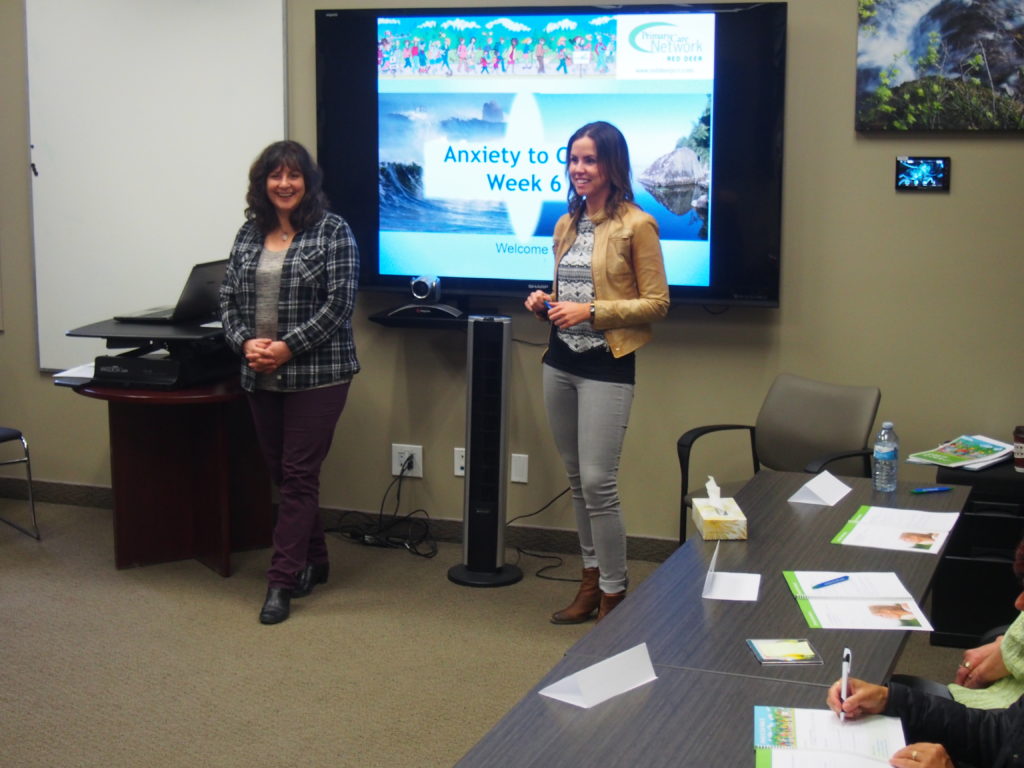
Frances knew she needed support.
Struggling with depression, stress, and an overly ambitious school schedule as a mature student, the central Alberta resident decided to try one-on-one counselling.
However, when that didn’t pan out for her, her physician suggested group therapy.
“I liked the idea of being with other people and seeing their perspective,” explained Frances (not her real name).
She signed up for Alberta Anxiety to Calm through the Red Deer Primary Care Network (PCN), and joined several other participants in the program, which is facilitated by two psychologists.
The two-hour weekly meeting was a game changer for her as she developed her own “tool kit” for dealing with anxiety — including breathing exercises, guided visualization, and affirmation.
About eight years ago, the RDPCN noticed 40 per cent of their referrals were to mental health counsellors with many suffering from anxiety. Those stats lead to the development of the “Anxiety to Calm” course.
“I like solving my own problems,” Frances says, noting that, while she took the course a few years ago, she still pulls out the tools she learned during those sessions when feeling anxious.
Frances isn’t alone in experiencing anxiety.
A 2013 Statistics Canada survey showed that one in four Canadians will have at least one anxiety disorder in their lifetime.
“We live in a fast-paced society,” says Lorna Milkovich, Red Deer PCN executive director. She points to social isolation, relationships, jobs, and parenting as just a few things that can lead to anxiety.
About eight years ago, the Red Deer PCN noticed 40 per cent of their referrals were to mental health counsellors for issues related to anxiety. Those statistics lead to the development of the Anxiety to Calm Course.
Empowerment is key
Milkovich says everyone has anxiety at some point in their lives, but dealing with it successfully comes down to management. The Anxiety to Calm Course offers lifelong skills with a focus on empowerment and cognitive behavioural therapy — which help participants learn more about how their thoughts and feelings can influence their behaviour.
We’re super proud of this because we know we’re offering top quality service to empower the people in our community to have a better quality of life.
– Lorna Milkovich
The eight-week course was so successful that participants noticed their anxiety levels had dropped by 50 per cent at its conclusion.
“We’re super proud of this because we know we’re offering top quality service to empower the people in our community to have a better quality of life,” Milkovich added.
The Red Deer PCN’s success with the course prompted staff to train facilitators in the Bow Valley and Drayton Valley PCNs among others.
The timing of this training was ideal for the Bow Valley PCN, says executive director Yvette Penman.
The PCN had just learned through the Health Quality Council of Alberta that the region (including Banff, Morley, Exshaw, Lake Louise, Canmore and other smaller communities) had a higher level of mental health issues, anxiety in particular, when compared with other areas of the province.
Although she can’t pinpoint what causes these higher levels of anxiety with any certainty, Penman suspects the mountain area’s transient — and often younger — population, the higher cost of living, and possibly congregate housing issues may play a part.
Self-management strategies
“We try to offer opportunities for people to learn about, self-manage and put strategies in place where it can benefit their health,” adds Adriana Storms, a behavioural change specialist with Bow Valley PCN. “We’re very happy to work with other [communities] to try and share ways that can give people these self-management strategies.”
A huge part of treating anxiety is simply showing up.
– Carla Mason
The prevalence of mental health issues in Bow Valley communities remains high, and the PCN is working to raise awareness of the supports available, says Penman. Those who participated in Anxiety to Calm reported their anxiety levels decreased by the end of the course.
At Drayton Valley PCN, attendees ranging in age from 18 to 70 years took the initial course and connected well, says registered social worker Jamie Thomas-Meronowich.
“A huge part of treating anxiety is simply showing up and the clients would actually express that when they arrived: ‘It was all I could do [to] walk through the door; I almost turned around,’” added her colleague, Carla Mason, a registered professional counsellor. “They became visibly proud of themselves when they would show up week after week.”
Looking back, Frances now realizes she was her harshest critic and the supportive group helped her recognize that fact.
“I was mentally hard on myself,” she concluded. “I built my own anxiety and I kept myself in my own prison. We can be so hard on ourselves that we forget about the positives … By the end of [the course] people were coming out of their shells.”
The Anxiety to Calm Course is currently offered at some PCNs across the province.
